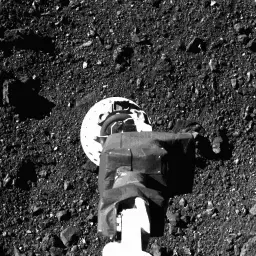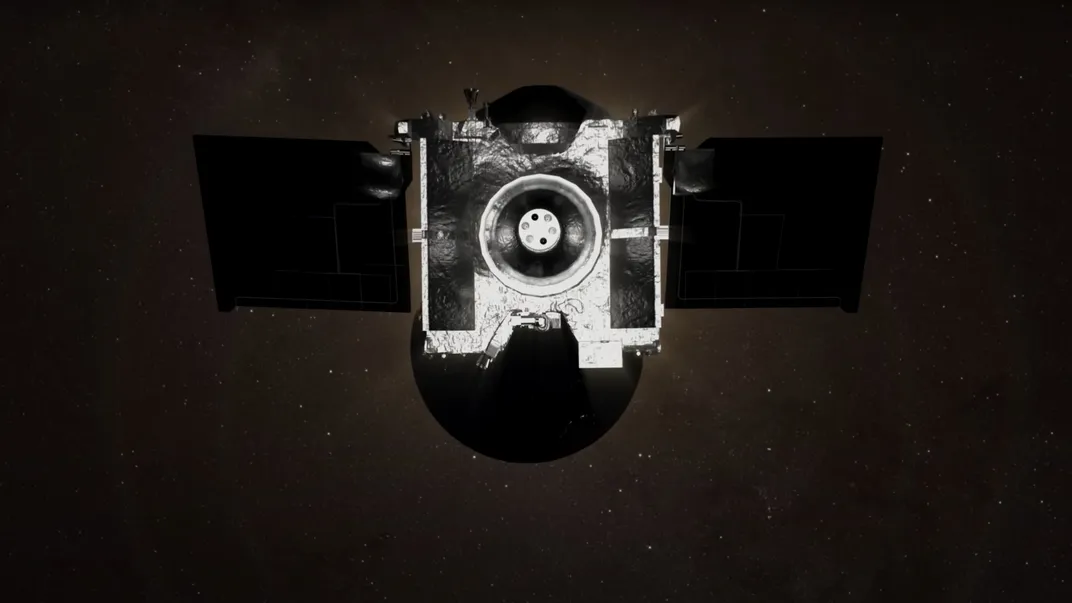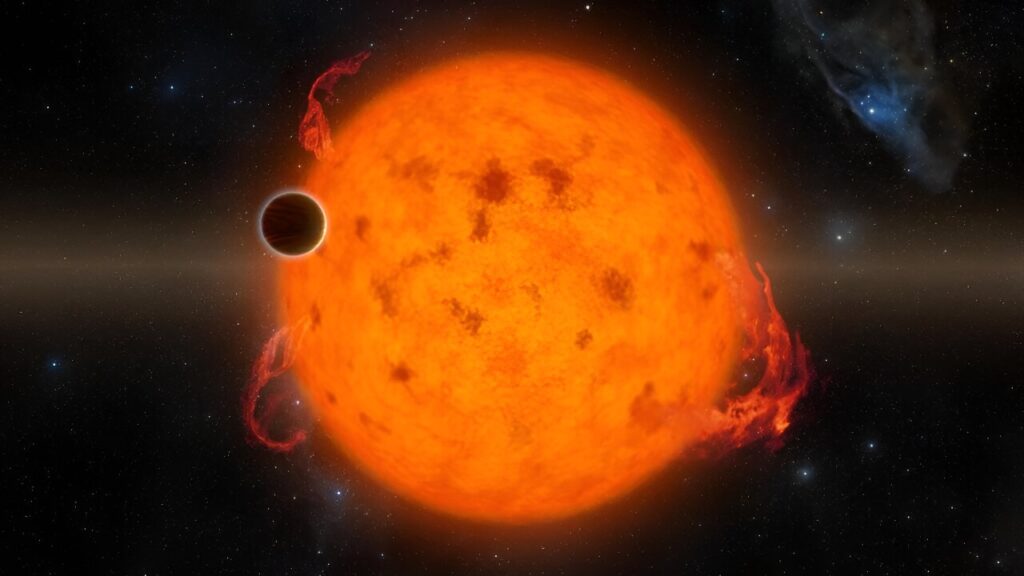Inside the bland, brick-and-steel Building 34 at NASA’s Goddard Space Flight Center in suburban Maryland, scientists are about to conduct a series of tests that will have profound results. They’re investigating about four grams of rock and dirt taken from asteroid Bennu as part of the OSIRIS-REx mission, which returned a spacecraft to Earth last September with a tiny payload — 121.6 grams in total, or less than five ounces . Present at the creation of the solar system, when clouds of gas and dust were coalescing into the sun and planets, the dirt awaiting analysis at the Goddard lab is among the oldest things on Earth. The spacecraft traveled 3.86 billion miles on a seven-year mission to collect it.
The “O” in OSIRIS-REx stands for “Origins”, which in this case refers to the beginning of everything on Earth. “This is the source of life, of oceans, of everything you know,” Tim McCoy said at the November 2023 discovery of a small piece of Bennu now on display at the Smithsonian’s National Museum of Natural History.
McCoy, the museum’s curator of meteorites, is analyzing other asteroid samples in the museum’s Department of Mineral Sciences to classify and describe the textures of the rocks and the types of minerals they contain. The sample that just arrived at the Goddard Analytical Astrobiology Laboratory will provide different information. I have come to the laboratory on this sultry June day to see how the scientists here will achieve it.
The OSIRIS-REx spacecraft collects a sample from Bennu. NASA / Goddard / University of Arizona
Laboratory director Jason Dworkin and Danny Glavin, a senior scientist for NASA’s sample return missions, meet me just outside what is known as a white room, which due to constant air filtration and personnel confined has air as dust- and bacteria-free as a neonatal intensive care unit. care unit. The room is furnished with benches topped with clear plastic checked boxes. We are separated from the white room by heavy plastic strips, like those used in a butcher shop to separate the cold store from the counter space. Through a window, I can see the small glass vial that holds four grams of the asteroid. For a moment, we all see it, and I half expect it to glow with the rarity, but it’s very dark, almost black, and looks like ash. “It’s contagious,” Glavin says. “It has a sticky, clay-like consistency. That’s basically what it is, like the mud we see on Earth.”
One thing scientists do know from data returned by the OSIRIS-REx spacecraft during its two-year orbit of Bennu is that at one point in the asteroid’s long history, it was wet. They also know that it is rich in carbon, the essential chemical component of all life on Earth. A team of analysts at the Carnegie Institution for Science reported that at 4.7 percent, the sample has the highest carbon abundance of any extraterrestrial sample — meteorite or returned material — that the institution has ever measured. And that’s where the Astrobiology Analytical Laboratory comes in.
A top-down view of the OSIRIS-REx Touch-and-Go Sample Acquisition Mechanism (TAGSAM) head with the cover removed, revealing the remainder of the asteroid sample inside NASA / Erika Blumenfeld & Joseph Aebersold/https://tf-cmsv2-smithsonianmag-media.s3.amazonaws.com/filer_public/5f/6a/5f6a6703-6b6a-4506-8276-afaec20defaa/opened_sample_return_canister_at_jsc.webp)
Scientists here want to understand how asteroids like this became part of the history of life on this planet. Astrobiologists believe that the nucleic acids RNA and DNA first evolved with some level of input from amino acids and other molecules that entered asteroids like Bennu billions of years ago. To test this hypothesis, they will study the organic molecules in the Bennu sample.
“Most of my work in the last 20 years has been on meteorites,” says Dworkin. “These are remnants of planet formation, and so on [they have] the raw materials that went to the planets from a mixture of the interstellar medium and the protosolar nebula.” On Earth, those raw materials have been obscured by tectonic and other geologic activity, by the heat generated by a flurry of impacts that occurred in the first billion years of the planet’s history, and by life itself just beginning to spread and evolve. , erasing her origin story. “There’s nowhere on Earth that we’ve ever seen that isn’t already inhabited,” says Dworkin.
But Bennu did not undergo any of those geological or biological processes; the word most often used by scientists on the OSIRIS-REx mission team to describe the samples is “pristine”. To keep this pristine, the lab follows careful protocols: People entering the white room where the sample resides wear masks, hairnets, lab coats, shoe covers, and nitrile gloves. An adhesive mat on the white door of the room traps any loose particles from shoe covers. The case that holds the glass vial of the sample is actually an airlock, with two clamps. Any small tool or object that enters the white room where the sample is held passes through one hatch, which is closed before the corresponding hatch on the other side is opened.
Glavin says that while they are happy to now be able to begin work, transporting the sample here and taking responsibility for it in the lab is stressful. “You can do the math,” he says. “The cost of the mission [roughly] $1 billion and we have 3.3 percent of the sample returned.” By this calculation, this half bottle of ash regolith is worth $33 million, but to scientists studying the origins of life, it is priceless. Dworkin has received other precious samples in his laboratory, including dissolved extracts from the asteroid Ryugu, brought to Earth by a Japanese spacecraft in 2020. He has been preparing the Bennu samples for 20 years – he joined the project in 2004, 12 years before the probe launched – and is one of 233 scientists worldwide representing 38 scientific institutions who will spend the next 15 months unlocking what everyone hopes will be the complete biography of Bennu. The 38 institutions will share only about 25 percent of the 121.6 grams of returned asteroid.
“We interpret organics in the context of mineralogy,” Glavin says. “We do not work in isolation. One set of experiments cannot tell the whole story.” The OSIRIS-REx science team published an introduction to this context late last month in the journal Science Meteoritics and Planetary Science. Mineralogists identified magnesium-sodium phosphates among the asteroid’s components, phosphate salts that can dissolve in water and that can participate in chemistry. It was a surprise discovery because the OSIRIS-REx sensors did not detect the phosphates while the spacecraft was mapping Bennu.
“That’s why sample return is so important,” says Glavin. Remote sensing cannot provide a complete account of the composition of a celestial body.
Phosphates are among the components of nucleotides, which in turn form the structural units of nucleic acids, such as DNA. Finding phosphates in the returned sample, says Dworkin, “allows[s] we ask the question whether these soluble phosphate salts may have contributed to the formation of phosphorylated organic compounds.
“We haven’t done any testing on these yet,” he adds.
One finding, mentioned in the paper almost in passing, worries me. Lindsay Keller, who manages the Electron Beam Analysis Laboratories at NASA’s Johnson Space Center, discovered grains thought to originate from red giant stars – stars that are older than the sun. Also found were traces of supernovae ejecta, the chemicals that burst outward in the fatal explosion of a star.
A door opens behind us and a young man announces that he will start the test. Angel Mojarro is a postdoctoral researcher who started at Goddard last February. “My first job out of high school is analyzing Bennu,” he says, with a smile that shows he considers himself incredibly lucky.
In a room where various types of mass spectrometers and other large instruments share space with computer monitors, Mojarro holds a glass vial in his gloved hands. In it, a small sphere the color of a poppy seed and about three times that size sticks to the glass. (This particle barely makes a scratch on the four-gram sample sent to the lab for processing; there is plenty of sample left.) Mojarro scoops it out with long metal tweezers and places it in a container in a gas chromatography mass spectrometer, i which looks a lot like an office printer, then closes a door. For a few seconds between removing it from the vial and placing it in the mass spectrometer, the Bennu particle is exposed to air, but given the test Mojarro is about to perform, Dworkin says the air exposure is negligible.
It looks small, but this asteroid sample weighs more than many of the other samples the Analytical Astrobiology Laboratory has studied. “We have in our laboratory part of the most pristine sample on Earth today of the early solar system. So I’m perfectly happy,” says lab director Jason Dworkin. Linda Shiner/https://tf-cmsv2-smithsonianmag-media.s3.amazonaws.com/filer_public/cf/95/cf95ae9e-88f8-490b-9c89-60c48657358e/bennu-particle2_web.jpg)
The mass spectrometer first vaporizes the particle by delivering a thermal shock, then pushes the resulting gas through coils of glass capillaries. The spectrometer measures the mass of individual molecules and generates a spectrum, indicating the chemical composition of the gas. In 90 minutes, Mojarro will have the result: a fingerprint of soluble and insoluble organic compounds in the asteroid sample. This information cannot be reported until the paper on this particular study is published later this year after it has been peer-reviewed.
An earlier similar test revealed the presence of many different amino acids, organic molecules that can be combined to form proteins. Most of them were glycine, the simplest in structure of all amino acids.
In addition to working with meteorites and asteroids, the Astrobiology Analytical Laboratory studied samples of Comet Wild 2 (pronounced “VILT-two”) returned in 2006 by NASA’s Stardust spacecraft. In 2008, Glavin and Dworkin isolated glycine from tiny comet tail grains. The next step was to prove that the glycine came from the comet, not from operations on Earth before the spacecraft launched. To confirm its extraterrestrial origin, they and their colleagues subjected microscopic amounts of Wild 2 to isotopic analysis that confirmed it came from space. It was the first observation of an amino acid from a comet. The discovery bolstered the hypothesis that the carbon-based ingredients required for life on Earth arrived at least in part as hitchhikers on the asteroids and comets that bombarded the planet in its infancy.
As scientists around the world conduct research on Bennu’s samples, asteroids are having a moment. The OSIRIS-REx spacecraft is continuing its mission, now at asteroid Apophis, and two other NASA probes are also on their way to other asteroids. Dworkin says his favorite part of the OSIRIS-REx mission is what will happen to the remaining 75 percent of the sample after it’s separated: “The rest goes into the future,” he says. For future scientists who will have better instruments for studying such material, who will know more about asteroids than today’s scientists and, says Dworkin, “who will ask questions we haven’t thought of .”


